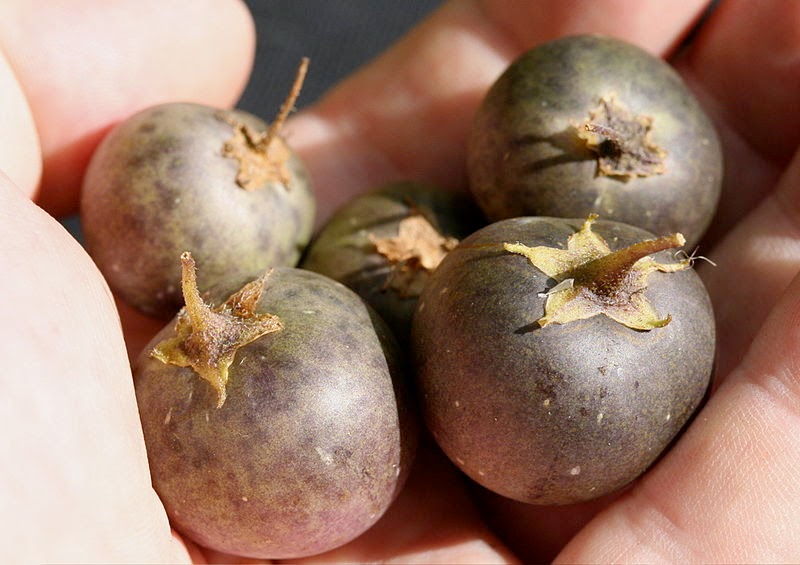Vincent van Gogh's The Potato Eaters.
We sure do love our potatoes. We have ever since people recognised their nutritional value and stopped feeding them solely to the pigs. The fact that the plant and fruits (yes, they produce small, tomato like fruits) are toxic, was the main cause of their initial rejection.
I mean, they don't seem very appetising to me either.
These days, we couldn't imagine a world without potatoes. I grew up eating plain boiled ones for dinner at least four times a week, every week (though we'd mash them together with some gravy on our plates, to add a bit more flavour). Every day at 4pm, my dad would give me and my sister an apple and some crisps as a snack. He'd put them in the same bowl, which turned the crisps at the bottom slightly soggy, something I do not recommend.
Then there were the rarer occasions of mash (homemade or instant), gnocchi, or 'stamppot'. This last one is arguably the most Dutch dish we have. The literal translation would be 'mash pot', and in its plainest form is nothing more than a highly unimaginative mashing together of vegetables and potatoes, sometimes dressed with crispy bacon cubes, smoked sausage, onions, and/or pickles, depending on individual taste and the chosen vegetable.
This is the ideal: an appetising dish that actually looks inviting.
But more often than not, it just turns out like this: a goo, drowning in gravy...
The most popular stamppot vegetables include sauerkraut, carrots, endive and kale, or 'boerenkool'
in Dutch. This translates to 'farmer's cabbage', which is also the name of the stamppot dish itself when prepared with kale. My family eats this version quite a lot, and I always wondered whether that's because my mother is a farmer's daughter. (We have a folklore tale along the lines of a stork delivering babies, only this version has children being discovered in cabbages and I have therefore always associated cabbage with offspring. Farmer's daughter and farmer's cabbage have always been oddly linked in my mind.)
My grandfather did actually grow potatoes on his farm. Officially these were for flour purposes (to make instant mash etc.), but my mother's family always kept a huge amount to eat for themselves, enough to last them until the next harvest. When I asked my mum about it, she shared some memories with me:
"As a little girl, I helped with selecting the potatoes. Standing in our barn, at a table and conveyor belt, I had to pick out the rotten ones. Part of the young potatoes we kept in a cool, isolated space, to sow the next season. All the other potatoes went to the flour factory up north. They were picked up in giant trucks. Sometimes even at night. In the harvest period, people worked 24/7 to transport the entire harvest of the north of the country to the factory. We ate them boiled, mashed and fried."
"In the end, I always want potatoes." Though for her the ultimate indulgence is mash and I usually crave them fried, Nora Ephron does hit the nail on the head when she talks about potatoes in her book Heartburn. For me, they are the ultimate comfort food, fighting for the top spot with chocolate. They are even more comforting when you don't have to prepare them yourself. In Pluk van de Petteflet, one of my favourite and earliest children's books, the 'Stampertjes' get to eat a giant bowl of fries whenever they're ill. Which, curiously enough, is every other chapter. They instantly feel better. The comfort probably doesn't come from the greasy, salty mountain of carbs, but more from the fact that their caring, food loving father prepares it just for them. Nora Ephron has a theory on this too: "when you're feeling blue the last thing you feel like is hard work. Of course, you can always get someone to make [them] for you, but let's face it: the reason you're blue is that there isn't anyone to make them for you." I would like to add that any attempt to recreate your parents' perfect potatoes never tastes as good, or not as good as you remember it to taste anyway.

The 'Stampertjes' were a lucky bunch.
© Fiep Westendorp
We have many different types of fried potatoes in the Netherlands: wedges, slices, chips, fries, 'krieltjes', etc. These last ones are tiny potato balls, cut out of bigger potatoes with a 'scooper spoon'. Though these days we buy them ready-made in the supermarket, an old cookbook of ours shows how to do it yourself:
These are my favourites still.
Lastly, I'd like to talk about condiments. No one eats fried potatoes in any form without a sauce of some kind. At every 'snackbar' (small shops where you can buy everything deep fried) you can order a 'patat met' (or 'fries with') and they'll top your chips with a giant dollop of mayonnaise (or 'frietsaus', a sweeter version with less fat). Of course you can also ask for ketchup. Though we've never heard of salt and vinegar, we do have a whole range of other sauces: saté (peanut sauce), 'oorlog' (meaning 'war': peanut sauce, mayonnaise and raw onions), speciaal (meaning 'special'; ketchup, mayonnaise and raw onions), curry ketchup, garlic sauce, Joppie sauce and many more.
And now I've gone and made myself very hungry, so if you'll excuse me, I've got some potatoes to fry.




.jpg)

























